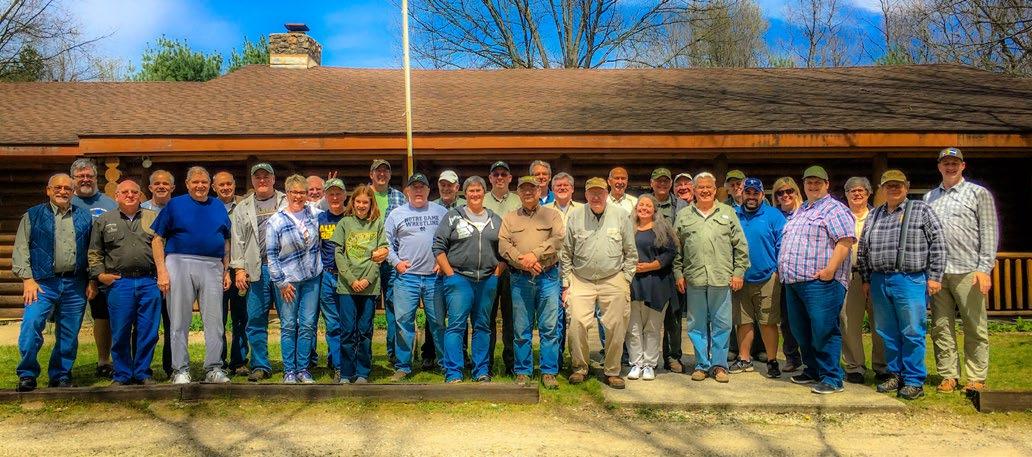
5 minute read
Fly Making Initiative Ties Charitable Organizations Together
A spontaneous act of generosity 15 years ago has snowballed into a culture of giving. In February 2007, Tim Scott and Terry Wittorp carpooled to the Kalamazoo Valley Chapter Trout Unlimited monthly meeting in Kalamazoo, MI to assist in planning the chapter’s upcoming summer youth camp. While driving home, Wittorp worried there wouldn’t be enough flies for the event. Scott suggested they recruit members from their FFI Affiliate Club, the Saint Joseph River Valley Fly Fishers of South Bend, IN, to help KVCTU in supplying flies for the children. To motivate members, Scott pledged to tie 100 flies, and Terry, a non-tier, offered to cook lunch.
A week later, 38 tyers met and produced 2,500 flies in Elkhart, IN. The Tie-a-Thon was born.
Ironically, both Scott and Wittorn envisioned the project as a one-off— at best, a periodic event. The group, however, begged to differ. “That was fun. Who are we tying for next year?” one participant said when the first Tie-a-Thon wrapped up. Another shouted, “I know of a Reel and Heal retreat in Ohio!” With that, the new direction was set.
The following spring, the tyers lived up to their promise and produced 3,700 flies for the Ohio retreat. That evening, Scott and Wittorp committed to organizing a yearly event, one which would benefit other charitable organizations that use fly fishing as therapy. They envisioned combat veterans, cancer survivors and at-risk youth—as well as youth fly fishing education groups—as the recipients of their efforts. But never could their vision have been so grand as to what it’s turned into.
What started as a local endeavor has now gone world-wide. A Facebook page, coupled with national media attention, has produced a group of tyers from 48 U.S. states, Canada, Scotland, Australia, and American Samoa. FFI affiliates DRiFT (IL) and Fly Girls (MI) have been consistent yearly donors, holding their own club “Tie-a-thons” and submitting thousands of flies. These international volunteers have donated 180,000 flies benefiting 18 charities over the past 15 years. Charitable organizations have included Project Healing Waters, the Mayfly Project and Casting for Recovery.
The Tie-a-Thon accepts any number of flies, but individuals donating at least 100 receive a t-shirt designed by Indiana fly fishing guide Andy Kitson.

Despite world events, 2020 proved to be a record-breaking year. While 2011 and 2019 produced an average of 10,000 charitable flies per year, in 2020, the Tie-a-Thon recorded upwards of 20,300 flies! Then in 2021, the record was broken again with a total of 34,400 flies tied.
For Stan Golub, CEO of Reel Recovery, an organization which facilitates free fly fishing retreats for men living with cancer, being the 2020 recipient of the Tie-a-Thon’s efforts was a charity’s dream come true. “They’ve stocked us for several years’ worth of retreats,” Golub said. “They gave such a wide assortment of flies for bass, trout, and bluegill, that we can customize distribution.”
Reel Recovery hosts, on average, 34 retreats per year. Golub said the variety and volume of flies will allow Reel Recovery to outfit each survivor with flies customized for specific regions. “Participants’ vests will be filled with flies to match their pursued species, and they will also receive a box of flies to take home,” Golub said. “After the experience, they keep those gift boxes to use for the rest of their lives. It’s pretty powerful stuff.”
For Trout Unlimited Youth Director Franklin Tate, the 2021 record setting donation to TU’s youth camps will assist all 25 camps in providing a memorable experience for the future ambassadors of fly fishing and conservation.
“These flies will be put directly into the hands of kids who will be starting their fly fishing journey,” Tate said. “One of the special parts of camp is when kids receive their fly box, and their eyes just light up!”
Breaking it down financially, Tate said each camp will receive approximately $2,000 in flies, freeing the directors to spend that money on other administrative costs. Like Golub, Tate believes the true power of the flies lies in the thought behind them.
“The Tie-a-Thon’s generosity is going to last the next decade and beyond. These flies will be fished for years and years to come, so it’s the gift that keeps on giving.”
Tim Scott thoroughly enjoys the random surprise waiting in each package. He was particularly moved by a young tier from Brooklyn, N.Y., who this year donated beautiful crab and shrimp saltwater patterns.
“His mother wrote a letter and said he read an article about us and wanted to donate,” Scott said.
The most rewarding part of the Tiea-thon, Scott suggests, is calling an organization out of the blue to tell them they will be receiving 10,000 flies.
After 15 years, the Tie-a-Thon is not slowing down. Due to its exploding success, they are now a 501(c)(3) charity and seeking corporate and individual sponsorships. In a world where good things often fade with time, Scott and Wittorp have created a living, generative culture of giving. It’s what keeps Wittorp going year after year.
“The camaraderie and the people we’ve come to know is bigger than fly fishing or fly tying,” Wittorp said. “The common good has gone global, and it’s nice to know there are so many people around the world who still care about other people.”
If you are interested in donating to the Tie-a-Thon or becoming a sponsor, contact the group at https://www. facebook.com/tieathon/.

BIO: Robert John Pales is a freelance writer, active FFI member and an enthusiastic Tie-a-Thon contributor. He lives in northern Indiana with his wife, twin sons and golden retriever and chases steelhead throughout the Great Lakes region nine months a year.
Robert John Pales










